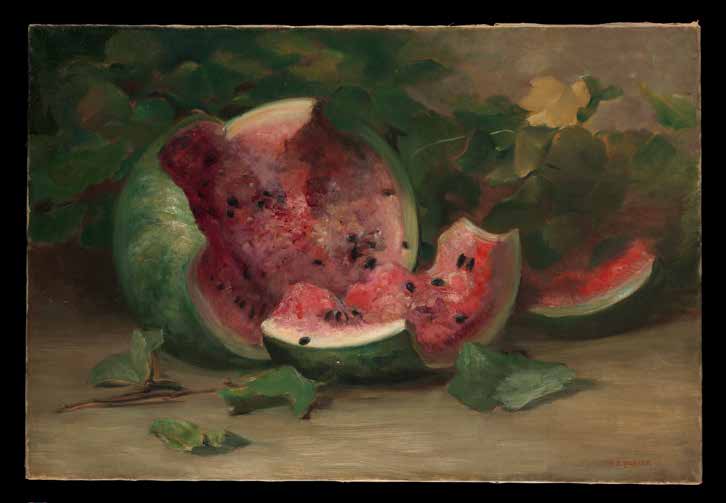
One of the most skilled and under-appreciated American still-life painters is supreme colorist Charles Ethan Porter (1847-1923). In his last years, Porter was reduced to such dire poverty that he could barely put food on the table. The irony is that while he was painting luscious apples and juicy watermelons his cupboards were bare.
One writer commented that because of racial prejudice in his Connecticut neighborhood, Porter had to ask a fellow painter, a Bavarian artist who shared his studio, to sell his paintings door to door because no one would buy the work of a black man. Often, Porter traded paintings or bartered them for necessities. Perhaps hundreds of his painting of fruits, flowers, insects, and landscapes still hang in Connecticut living rooms, unrecognized as the work of an artist with timeless skills. Ambitious curators or maybe the TV program Antique Road Show might turn up some hidden treasures someday.
Charles Evan Porter was born in Rockville, Connecticut, to a free African-American family. His talent was recognized early even in high school. In 1869, just a few years after the Civil War, he was the first African-American to attend the National Academy of Design in New York which was founded in 1825. After his studies, Porter set up a studio in Hartford which was visited by Frederick Edwin Church and another local resident, Mark Twain, both of whom recognized and admired his talent. By 1881 he had his heart set on studying in Paris. Porter sold about 100 of his paintings and moved to Paris where he attended the French National Academy for Decorative Arts and the Academie Julian.
“I am aware that there are a good number of my Hartford friends and others who are anxious to see how the colored artist will make out,” Porter wrote to Twain from Paris in 1883. “But this is not the motive which impresses me. There is something of more importance, the colored people –my people– as a race I am interested in, and my success will only add to others who have already shown wherein they are capable the same as other men.”
During his two years of study in France, Porter explored the French countryside and began painting landscapes incorporating elements of the then popular Impressionism in his work. Returning to Connecticut in 1884, the beauty of local fields and woods continued to inspire him. But times had changed. His new work didn’t sell. According to Michael Rosenfeld of the New York-based Michael Rosenfeld Gallery, Porter’s academic style was considered out-of-date. Rosenfeld has championed Porter’s work for almost 30 years. As an African-American painter Porter has been more or less overlooked until recently.
In 2008, the New Britain Museum of American Art assembled 51 paintings –still-life arrangements of flowers, fruits, vegetables– for the first museum exhibition of Porter’s work. His subjects depicted gentle imagery suitable for home décor. Other exhibitions followed and in 2015 Sylvia Yount, the Lawrence A. Fleischman Curator in Charge of the American Wing at the Metropolitan Museum of Art, acquired Porter’s “Cracked Watermelon,” a major Porter painting which you can see in the American Wing’s War and Reconstruction Eras and Legacies gallery.
An intimate porcelain plaque of roses, Porter’s only known decorative arts object, will be in The Met’s June show, New York Art Worlds, 1970-90. “An
unusual medium for Porter, the work suggests an experimental approach to what would become a favorite subject for the artist,” says Yount. “The Porter plaque reveals his savvy sense of fashionable taste – namely that associated with the Aesthetic Movement…”
Yount notes that “Porter is best known for his painterly, light-infused, table-top still lifes of fruit and flowers, but we’re excited to have a wider range of work at The Met that reveals him to be both talented and versatile, experimenting with different progressive styles and subjects in an effort to earn a living from his art –a challenge for any artist at any time, but especially for a black man in late 19th and early 20th century America.”
Michael Rosenfeld Gallery – 100 Eleventh Avenue, NYC – michaelrosenfeldart.com





Leave a Comment